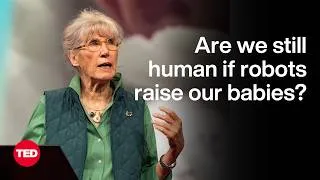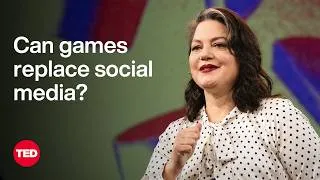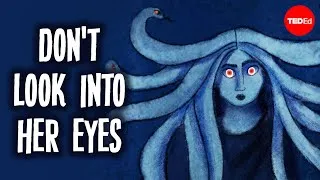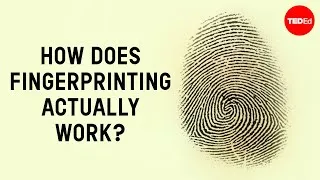请双击下面的英文字幕来播放视频。
翻译人员: Halei Liu
校对人员: Jenny Yang
00:12
Last year at TED we aimed to try to clarify
0
12160
4000
去年在TED我们试图用一个名为大视野的项目
00:16
the overwhelming complexity
1
16160
2000
来清晰地地展示
00:18
and richness that we experience at the conference
2
18160
3000
我们在TED大会上感受到
00:21
in a project called Big Viz.
3
21160
2000
及其复杂和丰富的信息
00:23
And the Big Viz is a collection of 650 sketches
4
23160
3000
大视野是由650张草图所组成
00:26
that were made by two visual artists.
5
26160
2000
这都是由两位视觉艺术家所做的。
00:28
David Sibbet from The Grove,
6
28160
2000
The Grove的大卫司比特,
00:30
and Kevin Richards, from Autodesk,
7
30160
2000
和Autodesk的凯文理查兹
00:32
made 650 sketches that strive to capture
8
32160
3000
他们所做的650张草图都致力于抓住
00:35
the essence of each presenter's ideas.
9
35160
4000
每个演讲者思维的奥义。
00:39
And the consensus was: it really worked.
10
39160
2000
而且共识是,这成功了。
00:41
These sketches brought to life the key ideas,
11
41160
4000
这些草图让这些关键的思维有了生命,
00:45
the portraits, the magic moments
12
45160
2000
这些肖像,这些神奇时刻
00:47
that we all experienced last year.
13
47160
2000
都是我们去年所经历过的。
00:49
This year we were thinking, "Why does it work?"
14
49160
3000
今年我们则在思考,"这为什么会成功?"
00:52
What is it about animation,
15
52160
2000
究竟是动画,
00:54
graphics, illustrations, that create meaning?
16
54160
3000
平面图像,插图的哪些东西创造了含义?
00:57
And this is an important question to ask and answer
17
57160
3000
不仅提出这个问题是十分重要的,同时回答也是十分重要的。
01:00
because the more we understand how the brain creates meaning,
18
60160
3000
因为我们越是了解大脑怎样创造含义,
01:03
the better we can communicate,
19
63160
2000
我们就可以更好的沟通。
01:05
and, I also think, the better we can think and collaborate together.
20
65160
3000
同时我也认为,这让我们可以更好的在一起思考和合作。
01:08
So this year we're going to visualize how
21
68160
2000
所以今年我们来看看
01:10
the brain visualizes.
22
70160
2000
大脑怎样去视觉化.
01:12
Cognitive psychologists now tell us that the brain
23
72160
2000
当代的认知心理学家告诉我们,大脑
01:14
doesn't actually see the world as it is,
24
74160
3000
看到的并不是世界本来的样貌,
01:17
but instead, creates a series of mental models
25
77160
3000
而是创造了一系列的心智模式
01:20
through a collection of "Ah-ha moments,"
26
80160
2000
这些模式是通过一系列的 "开窍时刻,"
01:22
or moments of discovery, through various processes.
27
82160
2000
或是在各种探索过程中获取的瞬间发现
01:24
The processing, of course, begins with the eyes.
28
84160
3000
这个过程,很显然,是从眼睛开始发生的。
01:27
Light enters, hits the back of the retina, and is circulated,
29
87160
3000
光线深入,刺激视网膜的后部,然后被分发,
01:30
most of which is streamed to the very back of the brain,
30
90160
3000
大部分是分流到大脑的最后一部分,
01:33
at the primary visual cortex.
31
93160
2000
那就是初级视觉皮层。
01:35
And primary visual cortex sees just simple geometry,
32
95160
3000
不过初级视觉皮层感知的是简单的几何型,
01:38
just the simplest of shapes.
33
98160
2000
只是一些简单的几何形状。
01:40
But it also acts like a kind of relay station
34
100160
3000
但是它同时也像一个中转站一样
01:43
that re-radiates and redirects information
35
103160
2000
把信息散布和转到
01:45
to many other parts of the brain.
36
105160
3000
大脑的不同部位,
01:48
As many as 30 other parts that selectively make more sense,
37
108160
3000
多达30个其他的区域选择性的创造意义
01:51
create more meaning through the kind of "Ah-ha" experiences.
38
111160
3000
通过一些"开窍"经验创造更多意义。
01:54
We're only going to talk about three of them.
39
114160
2000
我们只会讨论其中的三个。
01:56
So the first one is called the ventral stream.
40
116160
3000
第一个叫做腹面流。
01:59
It's on this side of the brain.
41
119160
2000
这是在大脑的这一边。
02:01
And this is the part of the brain that will recognize what something is.
42
121160
4000
大脑的这个区域将会识别这是什么东西。
02:05
It's the "what" detector.
43
125160
2000
这是一个"这是什么物体"的探测器。
02:07
Look at a hand. Look at a remote control. Chair. Book.
44
127160
4000
看看手,看看一个遥控器。椅子。书本。
02:11
So that's the part of the brain that is activated
45
131160
3000
所以大脑的这个区域将会被激活
02:14
when you give a word to something.
46
134160
2000
当你用一个词去描述一个东西的时候。
02:16
A second part of the brain is called the dorsal stream.
47
136160
3000
大脑的第二个部分叫做背流。
02:19
And what it does is locates the object
48
139160
3000
它的功能在实体物理空间里
02:22
in physical body space.
49
142160
3000
给对象定位。
02:25
So if you look around the stage here
50
145160
2000
所以如果你看看这个讲台的周围
02:27
you'll create a kind of mental map of the stage.
51
147160
3000
你会创造一种讲台的心理地图。
02:30
And if you closed your eyes you'd be able to mentally navigate it.
52
150160
3000
而且如果你闭上眼睛,你还可以继续在大脑内通过这个地图导航。
02:33
You'd be activating the dorsal stream if you did that.
53
153160
3000
如果你这样做的化,你就会激活这个背流。
02:36
The third part that I'd like to talk about
54
156160
2000
我将要谈到的第三个部分是关于
02:38
is the limbic system.
55
158160
2000
边缘系统。
02:40
And this is deep inside of the brain. It's very old, evolutionarily.
56
160160
3000
这个是在大脑的最深处。它十份古老,就进化而言。
02:43
And it's the part that feels.
57
163160
2000
它是创造感知的那个部位。
02:45
It's the kind of gut center, where you see an image
58
165160
2000
这就像一个器官中心,当你看到一个图片
02:47
and you go, "Oh! I have a strong
59
167160
2000
然后你觉得,"哦!我正在看的东西
02:49
or emotional reaction to whatever I'm seeing."
60
169160
4000
给我一个强烈的反映。"
02:53
So the combination of these processing centers
61
173160
3000
这样结合这些处理中心
02:56
help us make meaning in very different ways.
62
176160
4000
就可以帮助我们用不同的方法去创造含义。
03:00
So what can we learn about this? How can we apply this insight?
63
180160
3000
那么我们可以从中学到什么呢?我们如何运用这些我们所观察到的东西呢?
03:03
Well, again, the schematic view
64
183160
2000
我们再来图解一下:
03:05
is that the eye visually interrogates what we look at.
65
185160
3000
眼睛会询问我们所看到了什么。
03:08
The brain processes this in parallel, the figments of information
66
188160
3000
大脑则平行的处理这些虚构的信息,
03:11
asking a whole bunch of questions
67
191160
2000
同时问到很多问题
03:13
to create a unified mental model.
68
193160
2000
用来创造一个统一的心智模型。
03:15
So, for example, when you look at this image
69
195160
3000
这样,打个比方,当你看到这个图像
03:18
a good graphic invites the eye to dart around,
70
198160
3000
一个好的平面图像会邀请眼睛在这四周停留,
03:21
to selectively create a visual logic.
71
201160
2000
选择性的去创造一个视觉逻辑。
03:23
So the act of engaging, and looking at the image creates the meaning.
72
203160
5000
这种参与行为,注视图象的过程产生意义
03:28
It's the selective logic.
73
208160
2000
是一个选择性的逻辑。
03:30
Now we've augmented this and spatialized this information.
74
210160
3000
现在我们已经讨论过了和分类了这个信息。
03:33
Many of you may remember the magic wall that we built
75
213160
3000
你们中的许多人也许记得我们建造的魔术墙壁
03:36
in conjunction with Perceptive Pixel
76
216160
2000
那是运用了感知像素的
03:38
where we quite literally create an infinite wall.
77
218160
3000
那里我们实际上创造了一堵无限的墙。
03:41
And so we can compare and contrast the big ideas.
78
221160
2000
这样一来我们就可以比较和对比一些庞大的思维。
03:43
So the act of engaging and creating interactive imagery
79
223160
3000
那是用行为和创造互动的影像
03:46
enriches meaning.
80
226160
2000
来丰富含义。
03:48
It activates a different part of the brain.
81
228160
3000
这个激活了大脑的不同部分。
03:51
And then the limbic system
82
231160
2000
然后是边缘系统
03:53
is activated when we see motion, when we see color,
83
233160
3000
被激活,当我们看到动态,当我们看到颜色的时候,
03:56
and there are primary shapes and pattern detectors
84
236160
3000
然后这个初级形状和图案探测器
03:59
that we've heard about before.
85
239160
2000
就是我们之前听过的那个。
04:01
So the point of this is what?
86
241160
2000
那么这其中的意义是?
04:03
We make meaning by seeing,
87
243160
3000
我们通过看见的来创造含义,
04:06
by an act of visual interrogation.
88
246160
2000
通过一个视觉的审问。
04:08
The lessons for us are three-fold.
89
248160
2000
这给我们的启发是3方面的。
04:10
First, use images to clarify what we're trying to communicate.
90
250160
4000
第一,用图像来澄清我们所要交流的。
04:14
Secondly make those images interactive
91
254160
3000
第二,让这些图像是互动的
04:17
so that we engage much more fully.
92
257160
2000
所以我们会尽可能的投入自己的行为。
04:19
And the third is to augment memory
93
259160
2000
第三点是增强记忆
04:21
by creating a visual persistence.
94
261160
2000
通过创造一个持续性的视觉。
04:23
These are techniques that can be used to be --
95
263160
3000
这些都是可以被运用在 --
04:26
that can be applied in a wide range of problem solving.
96
266160
4000
这些技术可以被广泛运用在 解决各种领域的很多问题上 。
04:30
So the low-tech version looks like this.
97
270160
2000
所以低端的版本看起来是这样的。
04:32
And, by the way, this is the way in which
98
272160
2000
还有,顺便说一句 ,这就是我们怎么样
04:34
we develop and formulate
99
274160
2000
用Autodesk开发和
04:36
strategy within Autodesk,
100
276160
2000
制定计划的。
04:38
in some of our organizations and some of our divisions.
101
278160
3000
在我们一部分的机构和部门里,
04:41
What we literally do is have the teams
102
281160
2000
我们其实就是把所有的组员
04:43
draw out the entire strategic plan
103
283160
3000
集合在一堵巨大的墙前
04:46
on one giant wall.
104
286160
2000
来制定工作策略和计划。
04:48
And it's very powerful because everyone gets to see everything else.
105
288160
4000
这十分有用,因为每个人都可以看到每一个部分。
04:52
There's always a room, always a place
106
292160
2000
这里总有地方,总有一个地方
04:54
to be able to make sense of all of the components
107
294160
3000
可以让计划方针里的组件
04:57
in the strategic plan.
108
297160
2000
产生意义。
04:59
This is a time-lapse view of it.
109
299160
3000
这是一个快进的小电影。
05:02
You can ask the question, "Who's the boss?"
110
302160
2000
你可能问到,"谁是老板?"
05:04
You'll be able to figure that out. (Laughter)
111
304160
8000
你会找出来的。
05:12
So the act of collectively and collaboratively
112
312160
3000
那么集体分工合作的行为
05:15
building the image
113
315160
2000
建立起了图像
05:17
transforms the collaboration.
114
317160
3000
近而转化成合作。
05:20
No Powerpoint is used in two days.
115
320160
2000
在这两天里没有用到Powerpoint。
05:22
But instead the entire team
116
322160
2000
但是整个小组
05:24
creates a shared mental model
117
324160
2000
创造了一个分享的心智模型
05:26
that they can all agree on and move forward on.
118
326160
3000
这个模型都被他们认可而且可以近一步的发展。
05:29
And this can be enhanced and augmented with
119
329160
2000
这个过程可以通过采用新兴点子技术
05:31
some emerging digital technology.
120
331160
3000
而得到增强和补充。
05:34
And this is our great unveiling for today.
121
334160
3000
今天我们就要进行盛大的揭幕仪式。
05:37
And this is an emerging set of technologies
122
337160
2000
这个是一个新兴技术,
05:39
that use large-screen displays
123
339160
3000
使用大荧屏,
05:42
with intelligent calculation in the background
124
342160
3000
在后台拥有智能计算功能,
05:45
to make the invisible visible.
125
345160
2000
使不可见的内容视觉化。
05:47
Here what we can do is look at sustainability, quite literally.
126
347160
3000
这里我们可以非常直接地看到连续性。
05:50
So a team can actually look at
127
350160
3000
所以一个小组实际上可以看着
05:53
all the key components that heat the structure
128
353160
3000
组成结构的所有关键部分
05:56
and make choices and then see the end result
129
356160
2000
然后做出决定,再然后看到最后的结果
05:58
that is visualized on this screen.
130
358160
3000
这整个都被屏幕所视觉化了。
06:01
So making images meaningful has three components.
131
361160
3000
所以赋予图像含义有三个部件。
06:04
The first again, is making ideas clear by visualizing them.
132
364160
3000
第一个, 是通过视觉化他们来把想法解释的更清楚。
06:07
Secondly, making them interactive.
133
367160
2000
第二个,让他们具有互动成分。
06:09
And then thirdly, making them persistent.
134
369160
2000
然后第三个,让他们具有持久性。
06:11
And I believe that these three principles
135
371160
2000
而且我相信这3个原则
06:13
can be applied to solving some of the very tough problems
136
373160
4000
可以被运用到解决一些十分困难的问题上面,
06:17
that we face in the world today. Thanks so much.
137
377160
2000
一些世界上我们现在面对的问题上。十分感谢。
06:19
(Applause)
138
379160
2000
掌声
New videos
关于本网站
这个网站将向你介绍对学习英语有用的YouTube视频。你将看到来自世界各地的一流教师教授的英语课程。双击每个视频页面上显示的英文字幕,即可从那里播放视频。字幕会随着视频的播放而同步滚动。如果你有任何意见或要求,请使用此联系表与我们联系。







